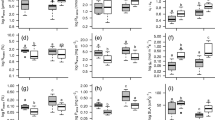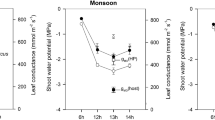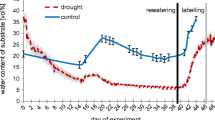Abstract
Xylem-tapping mistletoes transpire large volumes of water (E) while conducting photosynthesis (A) at low rates, thus maintaining low instantaneous wateruse efficiency (A/E). These gas-exchange characteristics have been interpreted as a means of facilitating assimilation of nitrogen dissolved at low concentration in host xylem water; however, low A/E also results in substantial heterotrophic carbon gain. In this study, host trees (Juniperus osteosperma) were fertilized and gas exchange of mistletoe (Phoradendron juniperinum) and host were monitored to determine whether mistletoe A/E would approach that of the host if mistletoes were supplied with abundant nitrogen. Fertilization significantly increased foliar N concentrations (N), net assimilation rates, and A/E in both mistletoe and host. However, at any given N concentration, mistletoes maintained lower A and lower A/E than their hosts. On the other hand, when instantaneous water-use efficiency and A/N were calculated to include heterotrophic assimilation of carbon dissolved in the xylem sap of the host, both water-use efficiency and A/N converged on host values. A simple model of Phoradendron carbon and nitrogen budgets was constructed to analyze the relative benefits of nitrogen- and carbonparasitism. The model assumes constant E and includes feedbacks of tissue nitrogen concentration on photosyn-thesis. These results, combined with our earlier observation that net assimilation rates of mistletoes and their hosts are approximately matched (Marshall et al. 1994), support part of the nitrogen-parasitism hypothesis: that high rates of transpiration benefit the mistletoe primarily through nitrogen gain. However, the low ratio of A/E is interpreted not as a means of acquiring nitrogen, but as an inevitable consequence of an imbalance in C and N assimilation.
Similar content being viewed by others
References
Caemmerer von S, Farquhar GD (1981) Some relationships between the biochemistry of photosynthesis and the gas exchange of leaves. Planta 153:376–387
Chapin FS III, Van Cleve K (1989) Approaches to studying nutrient uptake, use and loss in plants. In: Pearcy RW, Ehleringer JR, Mooney HA and Rundel PW (eds) Plant physiological ecology: field methods and instrumentation. Chapman and Hall, London
Davidson NJ, True KC, Pate JS (1989) Water relations of the parasite: host relationship between the mistletoe Amyema linophyllum (Fenzl) Tieghem and Casuarina obesa Miq. Oecologia 80:321–330
Dawson TE, King EJ, Ehleringer JR (1990a) Age structure of Phoradendron juniperinum (Viscaceae), a xylem-tapping mistletoe: inferences from a non-destructive morphological index of age. Am J Bot 77:573–583
Dawson TE, Ehleringer JR, Marshall JD (1990b) Sex ratio and reproductive variation in the mistletoe Phoradendron juniperinum (Viscaceae). Am J Bot 77:584–589
Ehleringer JR (1991) 13C/12C fractionation and its utility in terrestrial studies. In: Coleman DC, Fry B (eds) Carbon isotope techniques. Academic Press, San Diego
Ehleringer JR, Osmond CB (1989) Stable isotopes. In: Pearcy RW, Ehleringer JR, Mooney HA, Rundel PW (eds) Plant physiological ecology: field methods and instrumentation. Chapman and Hall, London
Ehleringer JR, Schulze E-D, Ziegler H, Lange OL, Farquhar GD, Cowan IR (1985) Xylem-tapping mistletoes: water or nutrient parasites? Science 227:1479–1481
Ehleringer JR, Cook CS, Tieszen LL (1986) Comparative water use and nitrogen relationships in a mistletoe and its host. Oecologia 68:279–284
Evans JR (1989) Photosynthesis and nitrogen relationships in leaves of C3 plants. Oecologia 78:9–19
Farquhar GD, O'Leary MH, Berry JA (1982) On the relationship between carbon isotope discrimination and the intercellular carbon dioxide concentration in leaves. Aust J Plant Physiol 9:121–137
Field C, Merino J, Mooney HA (1983) Compromises between water-use efficiency and nitrogen-use efficiency in five species of California evergreens. Oecologia 60:384–389
Field C, Mooney HA (1986) The photosynthesis-nitrogen relationship in wild plants. In: Givnish TJ (ed) On the economy of plant form and function. Cambridge University Press, New York
Flanagan LB, Ehleringer JR, Marshall JD (1992) Differential uptake of summer precipitation among co-occurring trees and shrubs in pinyon-juniper woodland. Plant Cell Environ 15:831–836
Givnish TJ (1986) Optimal stomatal conductance, allocation of energy between leaves and roots, and the marginal cost of transpiration. In: Givnish TJ (ed) On the economy of plant form and function. Cambridge University Press, Cambridge
Glatzel G (1983) Mineral nutrition and water relations of hemiparasitic mistletoes: a question of partitioning. Experiments with Loranthus europaeus on Quercus petraea and Quercus robur. Oecologia 56:193–201
Gregg JW (1991) The differential occurrence of the mistletoe, Phoradendron juniperinum, on its host, Juniperus osteosperma in the western United States. MS thesis, University of Utah
Goldstein G, Rada F, Sternberg L, Burguera JL, Burguera Orozco A, Montilla M, Zabala O, Azocar A, Canales MF, Celis A (1989) Gas exchange and water balance of a misteletoe species and its mangrove hosts. Oecologia 78:176–183
Heitholt JJ, Johnson RC, Ferris DM (1991) Stomatal limitation to carbon dioxide assimilation in nitrogen- and drought-stressed wheat. Crop Sci 31:135–139
Hellmuth EO (1971) Eco-physiological studies on plants in arid and semi-arid regions in western Australia IV. Comparison of the field physiology of the host, Acacia grasbyi and its hemiparasite, Amyema nestor under optimal and stress conditions. J Ecol 59:351–363
Hollinger DY (1983) Photosynthesis and water relations of the mistletoe, Phoradendron villosum, and its host, the California valley oak, Quercus lobata. Oecologia 60:396–400
Johnson JM, Choinski JS Jr (1993) Photosynthesis in the Tapinanthus-Diplorhynchus mistletoe-host relationship. Ann Bot 72:117–122
Küppers M, Küppers BIL, Neales TF, Swan AG (1992) Leaf gas exchange characteristics, daily carbon and water balances of the host/mistletoe pari Eucalyptus behriana F. Muell. and Amyema miquelii (Lehm. ex Miq.) Tiegh. at permanently low plant water status in the field. Trees 7:1–7
Lajtha K, Whitford WG (1989) The effect of water and nitrogen amendments son photosynthesis, leaf demography, and resource-use-efficiency in Larrea tridentata, a desert evergreen shrub. Oecologia 80:341–348
Marshall JD, Ehleringer JR (1990) Are xylem-tapping mistletoes partially heterotrophic? Oecologia 84:244–248
Marshall JD, Dawson TE, Ehleringer JR (1993) Gender-related differences in gas exchange are not related to host quality in the xylem-tapping mistletoe, Phoradendron juniperinum (Viscaceae) Am J Bot 80:641–645
Marshall JD, Ehleringer JR, Schulze JR, Schulze E-D, Farquhar GD (1994) Carbon isotope composition, gas exchange, and heterotrophy in Australian mistletoes. Funct Ecol 8:237–241
Miller RF, Angell RF, Eddleman LE (1987) Water use by western juniper. In: Everett RL (compiler) Proceedings — pinyon-juniper conference (USDA For Serv Gen Tech Rep INT-215) USDA For Seru, Washington, pp 418–422
Pate JS, True KC, Rasins E (1991) Xylem transport and storage of amino acids by S. W. Australian mistletoes and their hosts. J Exp Bot 42:441–451
Press MC, Shah N, Tuohy JM, Stewart GR (1987) Carbon isotope ratios demonstrate carbon flux from C4 hosts to C3 parasite. Plant Physiol 85:1143–1145
Raven JA (1983) Phytophages of xylem and phloem: a comparison of animal and plant sap-feeders. Adv Ecol Res 13:136–239
Reich PB, Walters MB, Tabone TJ (1989) Response of Ulmus americana seedlings to varying nitrogen and water status. 2. Water and nitrogen use efficiency. Tree Physiol 5:173–184
Schimel JP, Helfer S, Alexander IJ (1992) Effects of starch additions on N turnover in sitka spruce forests. Plant Soil 139:139–143
Schulze E-D, Ehleringer JR (1984) The effect of nitrogen supply on growth and water-use efficiency of xylem-tapping mistletoes. Planta 162:268–275
Schulze E-D, Turner NC, Glatzel G (1984) Carbon, water and nutrient relations of two mistletoes and their hosts; a hypothesis. Plant Cell Environ 7:293–299
Schulze E-D, Lange OL, Ziegler H, Gebauer G (1991) Carbon and nitrogen isotope ratios of mistletoes growing on nitrogen and non-nitrogen fixing hosts and on CAM plants in the Namib desert confirm partial heterotrophy. Oecologia 88:457–462
Sinclair TR, Horie T (1989) Leaf nitrogen, photosynthesis, and crop radiation use efficiency: a review. Crop Sci 29:90–98
Stewart GR, Press MC (1990) The physiology and biochemistry of parasitic angiosperms. Annu Rev Plant Physiol Plant Mol Biol 41:127–151
Toft NL, Anderson JE, Nowak RS (1989) Water use efficiency and carbon isotope composition of plants in a cold desert environment. Oecologia 80:11–18
Ullmann I, Lange OL, Ziegler H, Ehleringer J, Schulze E-D, Cowan IR (1985) Diurnal courses of leaf conductance and transpiration of mistletoes and their hosts in Central Australia. Oecologia 67:577–587
Waring RH, Schlesinger WH (1985) Forest ecosystems: concepts and management. Academic Press, Orlando
Author information
Authors and Affiliations
Additional information
This research was supported by the National Science Foundation (grants BSR-8706772 and 8847942).
Rights and permissions
About this article
Cite this article
Marshall, J.D., Dawson, T.E. & Ehleringer, J.R. Integrated nitrogen, carbon, and water relations of a xylem-tapping mistletoe following nitrogen fertilization of the host. Oecologia 100, 430–438 (1994). https://doi.org/10.1007/BF00317865
Received:
Accepted:
Issue Date:
DOI: https://doi.org/10.1007/BF00317865




